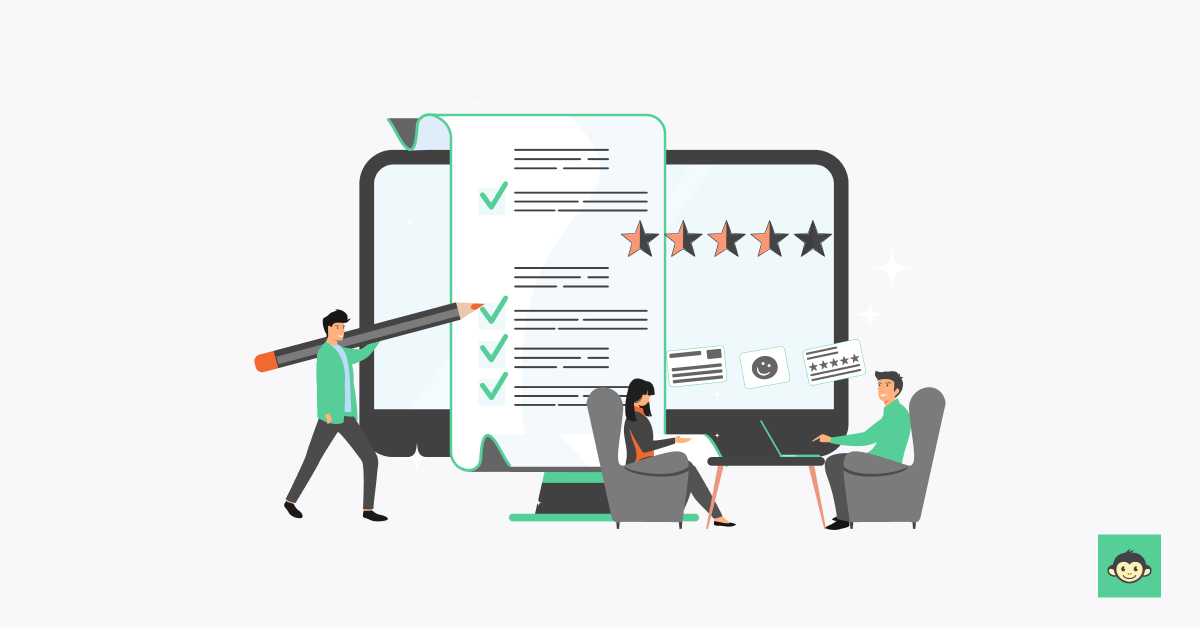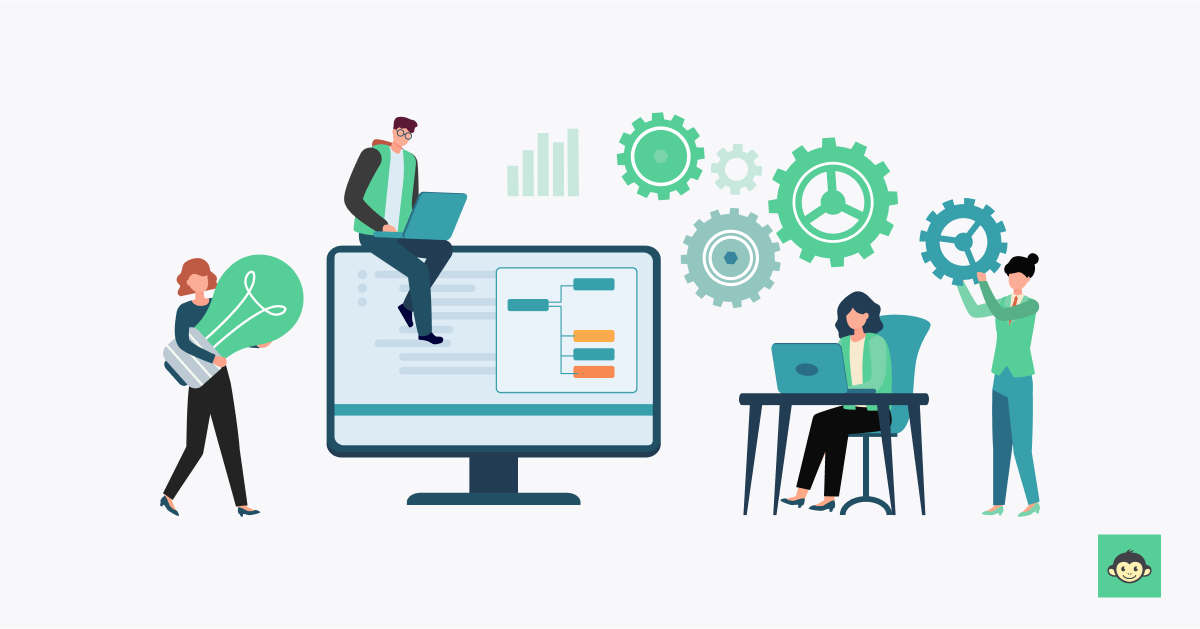What is employee enablement: 15 Top strategies + survey questions to try in 2024

Employee enablement isn't just a trending phrase; it's a powerful way to make your team happier and more successful. This blog will explain what employee enablement is, offer 15 great strategies to help your team thrive, and give you survey questions to track your progress.
So, what is employee enablement, and why does it matter? It's all about giving engaging employees on your team the right tools, support, and encouragement to do their best work. It's not just about making them feel good; it's about creating a culture where every team member feels valued, motivated, and capable of reaching their full potential.
To put it simply, consider this: According to a Gallup survey, companies with highly engaged employees make 147% more money than their peers. So, employee enablement isn't just about having happy employees; it's a smart way to boost productivity, innovation, and how well your company does.
Employee enablement meaning

Employee enablement is about nurturing an environment in which every employee can reach their full potential, both personally and professionally.
It's more than just job satisfaction; it's the art of equipping your own team members with the necessary tools, knowledge, and motivation to excel in their roles. In essence, it's about empowering your employees to become the best versions of themselves.
Imagine a workplace where every team member is not just content but inspired, where they have the autonomy to make decisions, take on challenges, and contribute their unique skills.
Employee enablement important in fostering a culture of trust and open communication, where individuals feel valued and heard. It's like providing them with the keys to a car but also encouraging them to drive and explore new horizons.
In this nurturing environment, employees are more likely to innovate, collaborate, and take ownership of their work. When they feel enabled, they are more engaged, creative, and enthusiastic, resulting in higher productivity and better overall job performance.
Employee enablement is a win-win situation: employees flourish, and the organization prospers. So, as a leader, embracing and championing employee enablement isn't just a choice; it's a strategic imperative in today's competitive business landscape.
What are the main objectives of employee enablement at work?

Understanding the primary objectives of employee enablement is a vital step toward creating a thriving and successful workplace.
By focusing on these objectives, you can strategically empower your team, enhance productivity, and foster an environment where both employees and the organization can flourish.
Boosting productivity
One of the primary goals of employee enablement is to maximize performance and increase productivity.
When employees have the right resources, knowledge, and motivation, they can perform their tasks more efficiently. This leads to higher output and a positive impact on the organization's bottom line.
Enhancing job satisfaction
Employee enablement aims to create a work environment where employees feel satisfied and fulfilled. When they are enabled to succeed, they experience a sense of accomplishment, which, in turn, improves their job satisfaction and overall happiness.
Fostering innovation
Another key objective is to promote innovation within the workplace. Enabled employees are more likely to come up with fresh ideas, problem-solving solutions, and creative approaches, leading to a culture of continuous improvement and innovation.
Increasing employee retention
When employees feel enabled, valued, and empowered, they are more likely to stay with their current organization. Reducing turnover and retaining talent is a significant goal of employee enablement, as it saves time and resources associated with the recruitment and onboarding process.
Improving employee engagement
High employee engagement is crucial for a company's success. Employee enablement is a powerful way to boost engagement, as enabled employees are more connected to their work and motivated to contribute their best efforts.
Enhancing employee development
A key objective is to provide opportunities for employee growth and development. Through training, mentorship, and continuous learning, organizations can enable their employees to acquire new skills and advance in their careers.
Cultivating a positive organizational culture
Employee enablement contributes to the development of a positive workplace culture where trust, open communication, and collaboration thrive. This, in turn, strengthens team cohesion and promotes a healthy, supportive environment.
Improving customer satisfaction
Enabled employees are more likely to provide exceptional customer service. Satisfied and motivated employees tend to be more customer-focused, which positively impacts satisfied customers.
Achieving business goals
Ultimately, the objective of employee enablement is to align individual employee goals with the organization's objectives.
When employees are enabled to succeed, it directly supports the achievement of the company's broader business goals and objectives.
Creating a competitive advantage
Employee enablement is not only about maintaining the status quo but also gaining a competitive edge.
Organizations that prioritize and excel in employee enablement often outperform their competitors', as enabled employees are more adaptable and agile in responding to industry changes and challenges.
Fostering a culture of diversity and inclusion
Employee enablement also aims to create an inclusive environment where diverse perspectives are valued and respected.
By embracing diversity, organizations can foster innovation, improve decision-making processes, and attract top talent from different backgrounds.
Promoting work-life balance
Another important objective is to support satisfied employees in achieving a healthy balance between their professional responsibilities and personal lives.
By offering flexible work arrangements, wellness programs, and promoting a culture of prioritizing well-being, organizations can enhance employee satisfaction and productivity.
Encouraging autonomy and accountability
Employee enablement involves empowering employees to make decisions and take ownership of their work.
By providing autonomy and holding employees accountable for their actions, organizations can foster a sense of responsibility and trust, leading to increased engagement and performance.
What is the difference between employee engagement and enablement?

Employee engagement and employee enablement are related but distinct concepts within the realm of workforce management. While they both contribute to a positive and productive work environment, they focus on different aspects and objectives:
Employee engagement:
- Emotional connection: Employee engagement primarily involves creating an emotional connection between employees and their work, colleagues, and the organization. It's about fostering a sense of belonging and dedication.
- Motivation and satisfaction: Engaged employees are motivated, enthusiastic, and satisfied with their jobs. They often go the extra mile to achieve the organization's goals.
- Feelings and attitudes: Engagement centers on the feelings and attitudes of employees, such as their passion, commitment, and enthusiasm. It aims to create a work environment where employees genuinely enjoy what they do.
- Building a sense of community: Employee engagement also focuses on building a strong sense of community within the organization. It encourages teamwork, collaboration, and camaraderie among employees, leading to a supportive and inclusive workplace culture.
Employee enablement:
- Empowerment and resources: Employee enablement is about equipping employees with the tools, resources, and support needed to perform their roles effectively. It focuses on empowering employees with the skills and knowledge required for success.
- Autonomy and decision-making: Enabled employees have a greater degree of autonomy and decision-making authority. They can take ownership of their work, make choices, and contribute to problem-solving and innovation.
- Performance and capability: Enablement emphasizes enhancing employee performance and capability through training, mentorship, and continuous learning. It's about making employees capable of reaching their full potential.
- Promoting a culture of learning: Employee enablement also encourages a culture of continuous learning and development within the organization. By providing opportunities for skill enhancement and personal growth, organizations empower employees to adapt to evolving roles and challenges.
While employee engagement is about creating a positive emotional connection, motivation, and satisfaction, employee enablement is about providing the resources, autonomy, and support necessary for employees to excel in their roles.
Both concepts are important, and a balance between them can lead to a highly motivated and empowered workforce that drives organizational success.
6 Employee enablement benefits you should know about

Employee enablement refers to the process of equipping and empowering employees with the tools, resources, and support they need to perform their jobs effectively. It goes beyond traditional training and development, encompassing a broader range of initiatives aimed at enhancing employee well-being, engagement, and productivity.
Here are six key benefits associated with employee enablement:
- Higher employee loyalty: Enablement fosters a sense of loyalty among employees. When they feel valued and supported, they are more likely to stay with the company for the long term.
- Better decision-making: Empowered employees have the confidence to make informed decisions, which can lead to faster and more effective problem-solving.
- Enhanced customer satisfaction: Enabled employees often provide better customer service, leading to increased customer satisfaction and loyalty.
- Reduced micromanagement: As employees become more capable and autonomous, leaders can reduce micromanagement, freeing up time for strategic tasks.
- Stronger employee advocacy: Empowered employees are more likely to speak positively about their organization, becoming brand ambassadors and attracting top talent.
- Improved organizational resilience: Employee enablement contributes to an agile and adaptable workforce, better prepared to navigate industry challenges and disruptions.
Incorporating employee enablement strategies into your organization not only benefits employees but also contributes to the overall success and prosperity of the company. It's a win-win approach that drives higher performance and creates a positive and thriving workplace.
What are the different dimensions of employee enablement?

Employee enablement encompasses several dimensions that collectively contribute to creating an empowered and thriving workforce. These dimensions include:
Access to resources
Providing employees with the necessary tools, technology, and resources to perform their tasks effectively. This includes access to information, equipment, software, and any other materials required for their roles.
Training and development
Offering continuous learning opportunities, training programs, workshops, and mentorship to help employees acquire new skills and advance in their careers.
Autonomy and decision-making
Granting employees the authority to make decisions within their roles. This dimension encourages a sense of ownership and accountability, empowering employees to take initiative.
Clear communication
Fostering open and transparent communication within the organization. Effective communication ensures that employees are well-informed, understand their roles, and can voice their concerns or ideas.
Recognition and feedback
Acknowledging and appreciating employees' contributions through regular feedback, performance evaluations, and recognition programs. Positive reinforcement boosts employee motivation and job satisfaction.
Work-life balance
Encouraging a healthy work-life balance by offering flexible work arrangements, time off, and other benefits that support employees' well-being outside of work.
Collaboration and teamwork
Promoting a culture of collaboration and teamwork where employees can work together to achieve common goals. Collaboration encourages knowledge sharing, collaborative learning and collective problem-solving.
Career growth and advancement
Providing opportunities for career growth and advancement within the organization. Clear pathways for promotion and professional development help retain talent.
Leadership support
Ensuring that leadership is supportive and leads by example when it comes to enabling employees. Leaders play a crucial role in fostering an environment of enablement.
Employee well-being
Prioritizing the physical and mental well-being of employees through wellness programs, health initiatives, and a supportive work environment.
Inclusivity and diversity
Promoting inclusivity and diversity within the workplace to ensure that all employees have equal opportunities and feel valued, regardless of their backgrounds or characteristics.
Goal alignment
Ensuring that individual employee goals align with the organization's overall objectives. This dimension helps create a shared sense of purpose and direction.
Each of these dimensions plays a vital role in enabling employees to thrive and reach their full potential. By addressing and nurturing these aspects, organizations can create a holistic employee enablement strategy that contributes to a positive and productive work environment.
5 Employee enablement examples

Employee enablement involves creating an environment where employees are equipped with the necessary resources, support, and opportunities to excel in their roles. Here are five examples of employee enablement initiatives:
- Professional development opportunities: Many companies offer opportunities for employees to further their education and skills through courses, workshops, or certifications. For instance, a tech company might provide coding classes for non-technical staff to enable them to better understand the product they're working on.
- Employee resource groups (ERGs): ERGs are employee-led groups formed around shared characteristics or life experiences. These groups provide a platform for networking, mentorship, and support. They enable employees to connect and collaborate, fostering a sense of belonging and empowerment.
- Flexible work arrangements: Enabling employees to have flexibility in their work schedules or the option to work remotely can significantly improve work-life balance. This flexibility allows employees to better manage personal and professional responsibilities, maximizing productivity and ultimately increasing job satisfaction and productivity.
- Innovation time: Some companies allocate a portion of an employee's workweek to explore innovative ideas or personal projects that align with the company's goals. This approach enables employees to contribute creatively to the organization and potentially develop new solutions or products.
- 360-degree feedback: Implementing a feedback system that includes input from peers, subordinates, and supervisors can be a powerful enablement tool. It provides employees with a comprehensive view of their strengths and areas for improvement, fostering personal and professional growth.
These examples demonstrate how organizations can empower their employees through various strategies, from educational opportunities to flexible work arrangements and inclusive feedback systems.
Common challenges and barriers in enabling employees as a leader

Enabling employees as a leader can be incredibly rewarding, but it also comes with its fair share of challenges and barriers. Here are some common hurdles leaders may face when trying to further empower employees on their teams:
Resistance to change
Employees may be resistant to new initiatives or changes in the workplace, particularly if they've been accustomed to a different way of doing things. Overcoming this resistance and managing the transition can be a challenge.
Lack of resources
Leaders may struggle to provide the necessary resources, such as budget, time, or tools, to assess employee enablement for their employees effectively. Limited resources can hinder the implementation of enablement strategies.
Cultural barriers
Existing workplace cultures that are resistant to empowerment or have a top-down management style can pose challenges. Shifting the culture towards one that embraces enablement may take time and effort.
Communication issue
Effective communication is essential for employee enablement and engagement. Misunderstandings, lack of clarity, or poor communication channels can hinder the process.
Resistance from middle management
Middle managers may be resistant to enabling employees, fearing a loss of control or feeling threatened by changes in the hierarchy. Overcoming this resistance and involving middle management in the enablement process is crucial.
Employee skills gaps
Employees may lack the necessary skills or knowledge to take on new responsibilities. Providing training and development opportunities to bridge these gaps can be a significant challenge.
Workload and time constraints
Employees may already have heavy workloads, making it difficult to take on additional responsibilities or engage in enablement activities. Finding ways to balance workloads while enabling employees is a juggling act.
Inconsistent leadership
Inconsistent leadership in the organization can hinder customer success and employee enablement efforts. If different leaders within the organization have conflicting approaches, it can create confusion and resistance.
Overcoming fear of failure
Employees may fear making mistakes or failing when given more autonomy or responsibility. Leaders must create an environment where failures are seen as opportunities for growth and learning.
Measuring and demonstrating ROI
Demonstrating the return on investment (ROI) of employee enablement initiatives can be a challenge. It's essential to establish clear metrics and ways to measure the impact of enablement efforts.
Aligning individual and organizational goals
Ensuring that individual employee goals align with the broader organizational objectives can be a complex task. It requires careful planning and clear communication.
Leaders need to be aware of these challenges and work proactively to address them. A successful enablement strategy often involves a combination of leadership skills, communication, change management, and a commitment to creating a supportive and empowering work environment.
How to set your employee enablement goals the right way?

Setting employee enablement goals is a critical step in creating a supportive and empowering work environment. Here's how to establish these goals effectively:
- Define clear objectives: Begin by clearly defining what you aim to achieve with your employee enablement goals. Are you focused on improving employee productivity, job satisfaction, innovation, or another aspect of employee enablement? The More specific your objectives, the easier it is to measure your progress.
Begin by clearly defining what you aim to achieve with your employee enablement goals. Are you focused on improving employee productivity, job satisfaction, innovation, or another aspect of employee enablement? The more specific your objectives, the easier it is to measure your progress. - Align with organizational goals: Ensure that your employee enablement goals are in alignment with the broader objectives of the organization. When both individual and organizational goals are harmonized, it promotes a shared sense of purpose and direction.
- Use SMART criteria: Employ the SMART (Specific, Measurable, Achievable, Relevant, Time-bound) criteria to structure your goals. SMART goals are clear, quantifiable, realistic, and have a set timeframe for achievement.
- Involve employees: Encourage employee participation in goal-setting. Employees are more likely to be motivated and committed to goals they have helped create. Consider conducting surveys or meetings to keep employees engaged and gather their input..
- Break down goals: Large, overarching goals can be overwhelming. Break them down into smaller, more manageable objectives or milestones. This makes progress tracking and achievement more attainable.
- Prioritize goals: Not all employee enablement goals may have equal importance or urgency. Prioritize them to focus on what will make the most significant impact on your team and organization.
- Set metrics and benchmarks: Identify key performance indicators (KPIs) and benchmarks to measure progress. Having specific metrics allows you to track your success and adjust your strategy if needed.
- Create a timeline: Establish a timeline for achieving your employee enablement goals. This provides a sense of urgency and helps keep the goals on track. Establish a timeline for achieving your employee enablement goals. This provides a sense of urgency and helps keep the goals on track.
- Provide resources: Ensure that employees have access to the necessary resources, such as training, other tools and resources, or support, to work toward these goals. Resource availability is crucial for goal attainment.
- Regularly review and adjust: Periodically review your employee enablement goals to assess progress and make any necessary adjustments. Goals should be dynamic and responsive to changing circumstances.
- Celebrate achievements: Recognize and celebrate milestones and achievements. Positive reinforcement can boost motivation maintaining productivity levels and morale.
- Communicate effectively: Clearly communicate the employee enablement goals to the entire team. Ensure that everyone understands the goals, their role in achieving them, and the benefits they will bring.
- Seek feedback: Encourage open feedback from employees about the goals and the enablement process. Their insights can help refine the goals and make them more effective.
By following these steps and principles, you can set employee enablement goals that are well-defined, achievable, and closely tied to your organization's business success, fostering a more motivated and empowered workforce.
15 Employee enablement ideas you should try in 2024

Employee enablement is an evolving aspect of organizational management, and trying new ideas can contribute to a more engaged and productive workforce. Here are ten employee enablement ideas to consider trying in 2024:
- Personalized learning paths: Create individualized learning journeys for employees based on their skills, goals, and learning preferences. Offer access to online courses, webinars, and resources that cater to their specific needs.
- Mentorship programs: Establish mentorship initiatives that pair experienced employees with knowledge management, with those seeking guidance and development. This fosters knowledge sharing and career growth.
- Wellness and mental health initiatives: Prioritize employee well-being by offering wellness programs, meditation sessions, or mental health support. A healthy mind and body are essential for employee enablement.
- Innovation challenges: Organize innovation challenges or hackathons to encourage employees to come up with creative solutions to company challenges. This promotes a culture of innovation and problem-solving.
- Cross-functional projects: Encourage employees to participate in cross-functional projects, allowing them to gain experience in different areas of the company. This broadens their skill set and perspective.
- Flexible work models: Implement flexible work arrangements, such as remote work options or compressed workweeks, to support work-life balance and cater to different employee needs.
- Recognition and rewards: Introduce a recognition and rewards program to acknowledge employees' contributions and achievements. Public recognition boosts morale and motivation.
- Feedback-focused culture: Create a culture of continuous feedback. Regularly solicit and provide feedback to employees, emphasizing growth and development.
- Diversity and inclusion initiatives: Promote diversity and inclusion within the organization. Implement diversity training, support groups, and policies that ensure equal opportunities for all employees.
- Corporate social responsibility (CSR) involvement: Encourage employees to engage in CSR activities. Allow them to participate in volunteer programs, which not only benefit the community but also foster a sense of purpose and pride among employees.
- Professional development stipends: Offer employees a stipend or budget dedicated to their professional development. This could include reimbursement for attending conferences, purchasing relevant books or courses, or obtaining certifications, giving employees more control over their learning journey.
- Peer-to-peer learning networks: Establish platforms or forums where employees can share knowledge, experiences, and insights with their peers across different departments or locations. This facilitates informal learning and collaboration, enriching the employee experience.
- Leadership training programs: Implement leadership development programs aimed at cultivating the next generation of leaders within the organization. Providing opportunities for aspiring leaders to enhance their skills and capabilities prepares them for future roles and responsibilities.
- Employee resource groups (ERGs): Create employee resource groups that cater to different demographics or interests within the workforce, such as women in leadership, LGBTQ+ employees, or working parents. These groups offer support, networking opportunities, and a sense of belonging.
- Job rotation opportunities: Offer job rotation programs that allow employees to temporarily take on roles in different departments or teams. This not only exposes them to new challenges and experiences but also helps in fostering a more interconnected workforce.
By embracing these employee enablement ideas, you can create a dynamic and supportive work environment that empowers your team to reach their full potential and drive the organization's success in 2024.
What is an employee enablement survey?

An employee enablement survey is a valuable tool that organizations use to assess the level of empowerment, support, and engagement among their employees. Unlike traditional engagement surveys, an employee enablement survey specifically focuses on evaluating the extent to which employees have the resources, opportunities, and motivation to excel in their roles.
These surveys typically consist of a set of carefully crafted questions designed to measure various aspects of employee enablement, such as access to resources, training and development opportunities, communication, autonomy, and the alignment of individual goals with the organization's objectives.
The primary purpose of an employee enablement survey is to gather feedback from employees regarding their perceptions of enablement within the workplace. It helps leaders and HR professionals identify strengths and weaknesses in their enablement strategies and pinpoint areas where improvements can be made.
The data collected from such surveys can guide organizational decisions and the development of enablement programs, ultimately contributing to a more empowered and engaged workforce.
Employee enablement surveys play a crucial role in enhancing the overall work environment, boosting productivity, and supporting the professional growth and satisfaction of employees.
13 Employee enablement questions you should ask in 2024

In 2024, consider asking the following employee enablement questions in your survey to gauge the level of enablement within your organization:
- Do you feel that you have access to the resources and tools necessary to excel in your role?
- Are you satisfied with the training and development opportunities provided by the organization to enhance your skills?
- To what extent do you feel that your opinions and ideas are valued and taken into consideration within the company?
- Do you have the autonomy and decision-making authority needed to effectively perform your job?
- Are you clear about how your individual goals and objectives align with the broader goals of the organization?
- Does your supervisor or manager provide you with the support and guidance you need to succeed in your role?
- How would you rate the communication within the organization, including feedback and transparency from leadership?
- Are you encouraged to take on cross-functional projects or roles to broaden your skill set and experience?
- Does the company have programs in place to support your well-being and mental health?
- Have you had the opportunity to participate in mentorship programs or initiatives aimed at career growth and development?
- Is there a recognition and rewards system in place to acknowledge and celebrate your contributions and achievements?
- Do you feel that diversity and inclusion are actively promoted and supported within the organization?
- Have you been involved in any corporate social responsibility (CSR) or community service activities facilitated by the company?
These questions cover various dimensions of the employee experience and enablement, including access to resources, communication, professional development, well-being, and alignment with organizational goals.
Role of leadership in fostering a culture of employee enablement

Effective leaders set the tone, establish priorities, and create an environment conducive to fostering employee empowerment, growth, and success.
Through their actions, decisions, and communication, leaders can inspire and motivate employees to reach their full potential and contribute meaningfully to organizational goals.
- Visionary leadership: Leaders articulate a clear vision for the organization's future and communicate how workforce enablement aligns with strategic objectives. A compelling vision inspires employees and provides a sense of purpose and direction.
- Supportive environment: Leaders create a supportive environment where employees feel valued, respected, and empowered to voice their ideas, concerns, and aspirations. They encourage open communication, collaboration, and trust within the team.
- Lead by example: Effective leaders lead by example, demonstrating the behaviors and attitudes they expect from their employees. They model transparency, accountability, and a commitment to continuous learning and improvement.
- Coaching and mentorship: Leaders invest in coaching and mentorship programs to develop employees' skills, confidence, and leadership potential. They provide guidance, feedback, and opportunities for growth and development.
How do you measure employee enablement?

Measuring employee enablement is essential for organizations seeking to gauge the effectiveness of their initiatives in empowering employees and fostering a culture of continuous improvement.
While intangible in nature, employee enablement can be assessed through a combination of qualitative and quantitative metrics that reflect employees' skills, autonomy, engagement, and overall contribution to organizational goals.
- Employee satisfaction surveys: Regularly administer surveys to gauge employees' perceptions of the resources, support, and opportunities provided by the organization to enable their success. Assessing satisfaction levels can provide valuable insights into areas for improvement and identify factors contributing to workforce enablement.
- Performance reviews: Evaluate employee performance against predefined goals and expectations, considering factors such as productivity, innovation, and collaboration. Performance reviews offer a structured framework for assessing the impact of enablement initiatives on individual and team outcomes.
- Skill development metrics: Track employees' participation in training programs, certifications, and skill-building activities to measure their progress and proficiency in relevant areas. Analyzing skill development metrics helps determine the effectiveness of enablement efforts in enhancing employees' capabilities and adaptability.
- Employee engagement levels: Measure employee engagement through surveys, feedback mechanisms, or pulse checks to assess their level of connection and commitment to their work and the organization. High levels of engagement often indicate that enablement initiatives are resonating with employees and driving positive outcomes.
- Autonomy and decision-making authority: Evaluate the degree of autonomy and decision-making authority granted to employees within their roles. Assess whether employees have the freedom and empowerment to make meaningful contributions and drive initiatives independently.
- Employee retention and turnover rates: Monitor employee retention rates and turnover trends to understand the impact of enablement initiatives on employee satisfaction and loyalty. A lower turnover rate suggests that employees feel valued, supported, and enabled to succeed within the organization.
- Business impact metrics: Assess the tangible business outcomes resulting from employee enablement efforts, such as increased productivity, innovation, customer satisfaction, and revenue growth. Linking enablement metrics to broader business goals demonstrates the ROI of investing in employee development and empowerment.
Role of an employee survey tool in gauging and improving your employee enablement needs?

Employee survey tools play a crucial role in gauging and improving employee enablement needs within an organization. Here's how these tools contribute to the process:
Data collection
Employee survey tools are instrumental in collecting quantitative and qualitative data from employees regarding their perceptions, experiences, and needs related to enablement. These tools allow organizations to gather feedback efficiently and comprehensively.
Objective assessment
Surveys provide an objective assessment of the current state of employee enablement. By asking specific questions and gathering data, organizations can gain a clear and accurate understanding of what is working well and where improvements are needed.
Benchmarking
Employee survey tools often allow organizations to benchmark their results against industry standards or best practices. This benchmarking helps to determine how an organization's enablement efforts compare to peers, identifying areas for growth.
Identifying pain points
Through survey responses, organizations can identify pain points and specific challenges employees face in terms of enablement. This information is valuable for making targeted improvements.
Tailored strategies
Survey results guide organizations in tailoring enablement to implement strategies and address the unique needs and concerns of their employees. For example, if a survey indicates a lack of training opportunities, the organization can prioritize creating relevant training programs.
Employee involvement
Involving employees in the survey process fosters a sense of ownership and empowerment. It shows that their input is valued and that the organization is committed to enhancing their enablement.
Continuous improvement
Employee survey tools support a culture of continuous improvement. Organizations can regularly conduct employee surveys, to track progress, measure the impact of changes, and make adjustments accordingly.
Communication and transparency
The mere act of conducting surveys demonstrates a commitment to open communication and transparency. Sharing survey results and the resulting action plans with employees promotes trust and engagement.
Prioritization
Survey data helps organizations prioritize enablement initiatives based on real employee feedback. This ensures that resources and efforts are directed where they will have the most significant impact.
Measuring ROI
Employee survey tools enable organizations to measure the return on investment (ROI) of their enablement efforts. By comparing survey results over time, they can assess the impact of changes on employee enablement and organizational performance.
Conclusion
Employee enablement is no longer a choice but a strategic imperative. It's the key to a more productive, engaged, and successful workforce. By implementing the 10 strategies outlined and regularly conducting employee enablement surveys, you can create an environment where your team thrives.
Ready to take your employee enablement to the next level?
Connect with CultureMonkey – your partner in creating an empowered and prosperous workplace. Let's make 2024 a year of growth, innovation, and a culture that values its people like never before.
FAQs
1. What does enablement mean in the workplace?
Enablement in the workplace refers to the process of equipping employees with the necessary tools, resources, and support to perform their roles effectively and reach their full potential. It involves empowering employees with the skills, knowledge, and autonomy needed to succeed, fostering a culture of continuous learning, growth, and innovation. Employee enablement encompasses providing opportunities for skill development and teamwork.
2. How does employee enablement differ from traditional training and development programs?
Employee enablement differs from traditional training and development programs in its holistic approach to employee growth. While traditional programs focus primarily on imparting specific skills or knowledge, enablement encompasses a broader spectrum of support. It emphasizes empowering employees with the resources, autonomy, and encouragement to take ownership of their learning journey and apply their skills effectively in diverse contexts.
3. How can organizations promote employee enablement in a remote or hybrid work environment?
In a remote or hybrid work environment, organizations can promote employee enablement by leveraging technology to facilitate seamless communication, collaboration, and access to resources. Providing remote training and development opportunities, mentorship programs, and virtual team-building activities fosters a sense of connection and empowerment among remote employees. Flexible work arrangements that accommodate individual preferences also contribute to enablement.
4. How can organizations sustain employee enablement over the long term and ensure that it remains a priority?
Organizations can sustain employee enablement over the long term by integrating it into their core direct value and strategic objective. This entails fostering a culture of continuous learning, innovation, and empowerment through consistent communication, leadership support, and recognition of enablement initiatives. Providing ongoing opportunities for skill development, feedback, and career advancement reinforces the importance of employee enablement.



